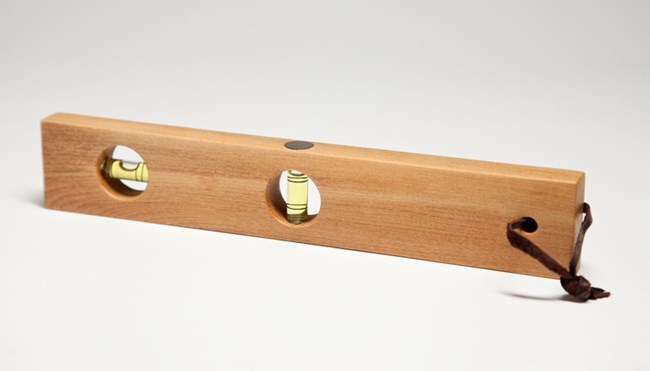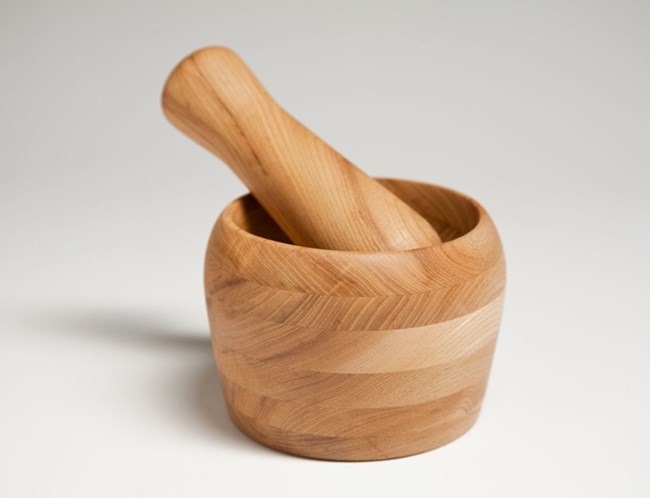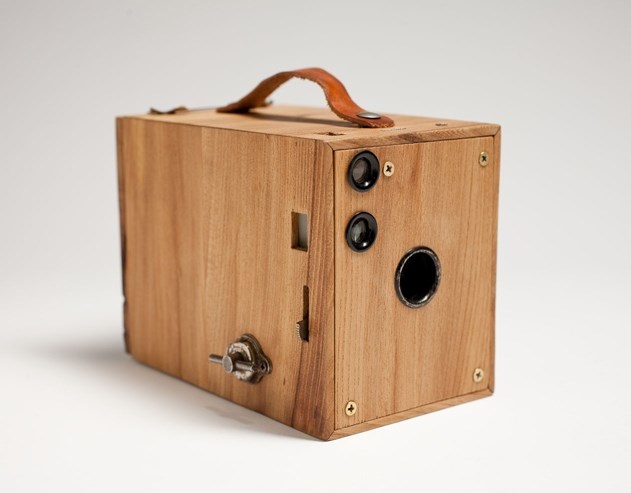Part of a series of articles titled Echoes of the Olmsted Elm: Works from the Rhode Island School of Design Witness Tree Project.
Article
Echoes of the Olmsted Elm Assignment One
Frederick Law Olmsted was a man of many interests and occupations. Some more successful than others. Choose one of these occupations and make an object that you think Olmsted would have wanted to have with him during the practice of the chosen occupation.

Level by Andrea Parikh
Before his famous career as a landscape architect was launched, Olmsted spent two years as superintendent of the labor force clearing land for Central Park. During this period he spent a significant amount of time work-ing in the field getting to know the desolate and rocky terrain of the site. With this in mind, this level is meant to represent Olmsted’s meticulous onsite observations and commitment to detail. Olmsted could have used the device to establish a horizontal plane when level-ing earth for the creation of the first landscaped public park in the United States. The design reinterprets the common tool – usually made from aluminum or plastic – using an uncommon material, intending to provoke the viewer’s thoughts about materiality and construction.
Plumb Bob and Tripod by John Adams
Among Olmsted’s many professions, his work as a surveyor stood out to me because of the importance of precision tools. As a surveyor, Olmsted would have laid out a grid work in order to document key features of the landscape. To do this properly, numerous measuring devices must be utilized. Among them, a plumb line is necessary to ensure the trueness of vertical grid lines. In my plumb bob I aspired to establish a balance of round and straight features by rounding over the top and chamfering the bottom. This balance is a reference to the balance Olmsted strove to find in his environments. I also added a brass tip in order to increase the weight of the plumb and allow for a greater degree of precision, as I perceive Olmsted to have been very exacting. To hold the plumb bob and establish the plumb line, I decided to make a tripod. Traditionally plumb bobs are held by an A-frame consisting of two legs and a cross member along which markings can be made. I thought an A frame would be too cumbersome for Olmsted’s active lifestyle, so I instead designed a more compact telescoping tripod. In the tripod I also incorporated round and straight elements with rotated forms and more chamfers.
Netting Shuttle by Karl Sippel
The net shuttle is a tool that cord is wound around and used to create and repair nets. The natural utility of nets would have made this tool indispensable on any ocean going voyage. From holding down cargo to creating a ladder, Frederick Law Olmsted would have inevitably utilized a net during his time as a merchant sailor and thus I feel that during his days at sea Olmsted would have wanted a net shuttle to create and maintain these valuable tools.
Mortar and Pestle by Tina Xu
Being a dry goods clerk can be a very uneventful occupation. Frederick Law Olmsted would most definitely agree with this. However, with the use of a simple tool, a repetitive, dull vendor can become a magician, a doctor, and a cook. The mortar and pestle can transform those shelves of spices and herbs into an endless number of delicious or medicinal concoctions. The act of grinding things in this small handmade mortar would be meditative and satisfying, as Olmsted would study the rings of the wood and trace them with his pestle. As well, any sort of frustrations with his unhappy days can be released in the pounding and crushing of goods. Its simple but timeless form made to fit comfortably in the hand is something Olmsted should never tire of. Considering how miserable he felt during his time on the job, this small but effective tool could have given him that daily spark of creativity and productivity he didn’t yet know he longed for.
Walking Stick by August Lehrecke
In designing an object that I think Olmsted would have had use for in his extensive and varied career, I tried to narrow my scope down to something at the core of his work and philosophy. What I eventually came to was the act of walking, something that I think Olmsted was very attached to. In reading his accounts in Walks and Talks of an American Farmer in England, one can glean a very analytical and observational approach in his writing. Through walking around and reflecting upon the things that he saw, Olmsted developed much of the ideas and aesthetics that he brought into his later, more recognized, works as a landscape architect. He also traveled to the south of the U.S. and published an account of his observations there. Exploration and observation seem to be things that were carried through all stages of his career. To aid him in this process, I chose to make a walking stick, something that would accompany and aid him in his leisurely observations. Something I think that is nice about Olmsted’s designed landscapes is the freedom he allows you to find your own path, encouraging some exploration and contemplation. I think that Olmsted would have liked to have a reliable walking stick by his side, to lean on as he observed his surroundings.
Box Camera by Jonah Willcox-Healey
I began by finding a common element between my lifestyle and that of Frederick Law Olmsted’s and ended up focusing on the role of photography. Throughout Olmsted’s career photography was well as drawings were the main ways to document all the parks that he worked on. I began to research the types of cameras used back in the 1900s and came across the Kodak No 2 Box Camera. As a photographer and camera collector I had an old rusted and torn camera of this model and decided to reconstruct the camera and restore it to working condition with the aid of the Olmsted Elm. The process began by converting the dimensions and components of the paper bodied camera into wood and combining parts to make an easier constructed camera. When constructing the camera I choose to use materials that were of the same era as Olmsted to create a more authentic feel.
Axe by Samantha Anderson
As a farmer and landscape architect, Olmsted had use for a small axe in both the utilitarian and symbolic sense. My intent in shaping a handle for this tool is to describe the nature of Olmsted’s relationship with the environment. An axe handle represents a tool meant for a man who manipulated the landscape- it is symbolic as a tool for landscape design and also as a tool for various jobs on a farm.This specific handle is designed to recall the topography of the land that Olmsted was so connected to throughout his many careers, especially as a landscape architect and farmer. The curves, twists, and bends undulate under the grain, whose rings evoke topographical notation. In a poetic cycle, the wood of Olmsted’s Elm is recycled into a wooden tool whose use is to modify wood.

French Curves by Hilary Wang
When trying to choose an object to construct that Olmsted would have liked to use or had with him, I was leaning towards something that would reflect his deep appreciation for nature. With that in mind, I decided to focus on the period of his life in 1857, when he became the superintendent of Central Park. I felt that a key tool that Olmsted would have benefited from during the drafting process would have been French Curves, also known as Burmester Curves after the inventor Ludwig Burmester.I felt that the iconic S shape bends reflect the sense of having been organically calculated. The same calculated measures that Olmsted took in designing his landscapes. The French Curves represent Olmsted’s obsessive perfection towards designing Central Park. The French Curves, in my mind, also reflect the lay out of Central Park, the first of many parks he designed after; which is mostly comprised of curving swatches of greenery with paths weaving through. I chose to negate the conventional negative cutouts and stuck with just circles that could act as finger grips or a hole to hook on for storage. The addition of the pouch represented the utilitarian aspect of being able to travel with them on site, or during his visits to other park sites.
Last updated: April 8, 2022
